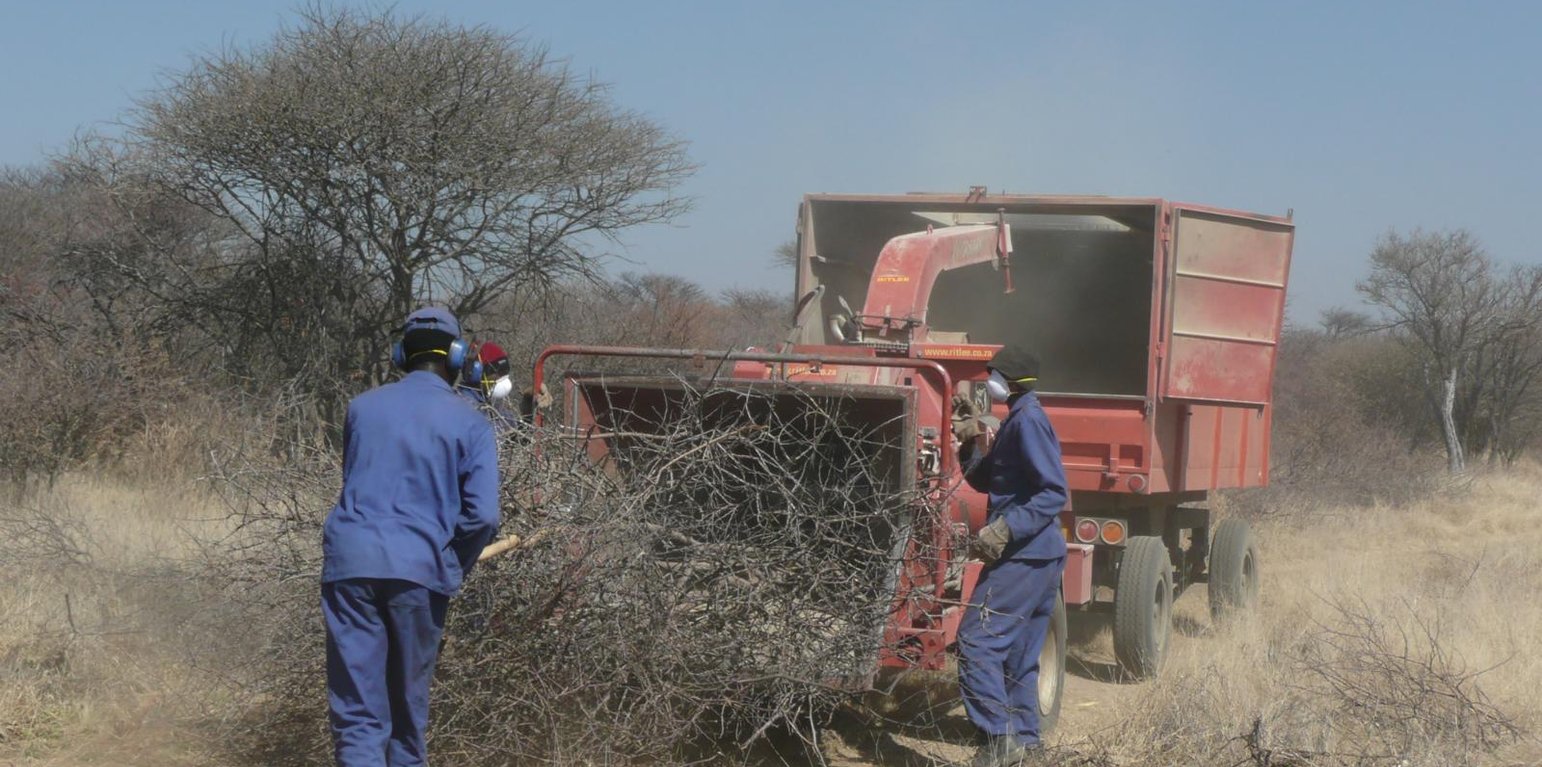



Bush thinning is carried out in Namibia to restore degraded rangeland by stimulating the re-growth of grasses – which are suppressed by excess bush. About 30-45 million hectares are affected by bush encroachment, and this affects biodiversity, groundwater recharge and the carrying capacity of rangeland. There are many causes of bush encroachment, including overgrazing and reduced frequency of wildfires. Most bush encroachment involves indigenous, rather than invasive, species.
While natural transitions in the ecosystems may lead to reductions in bush encroachment, active rehabilitation measures are required for the short-term improvements. This is an absolute necessity for many farmers, who experience severe economic difficulties due to the reduced productivity of their rangeland.
Bush control comprises responsive measures (bush thinning), follow-up measures (aftercare) as well as preventative measures (good rangeland management). Since vast areas of Namibian rangeland are heavily encroached by bush, the focus is currently on bush thinning. This entails selective harvesting of bush. To determine the density of bush remaining after thinning, a formula based on tree equivalent (TE) and average annual rainfall is used. One TE is defined as a woody tree or bush of 1.5 metres in height.
As rule of thumb for attaining optimal bush density, about 30-35% of encroacher biomass should be removed. This is based on research carried out mainly in South Africa, measuring and comparing the re-growth after bush removal. Where too much bush was removed, this often resulted in even heavier encroachment.
Bush thinning follows strict environmental guidelines set by the Directorate of Forestry (DoF) through the Forestry Act and the Directorate of Environmental Affairs (DEA) through the Environmental Management Act. This governs the equipment used (to avoid soil disturbance) and the amount of bushes harvested (to achieve a healthy number of the desired bush species). The amount of bushes to be harvested is determined by an expert and depends on various factors.
While there is a lack of precise knowledge on the long-term effect of bush thinning, there is no doubt that control has an overall positive effect on the savannah ecosystem in Namibia. The need is widely recognised among land owners and acknowledged on the national political agenda.
To render bush thinning economically feasible, value chains have been developed. Through processing and utilisation of the woody biomass, income can be generated. Processed bush biomass can, for example in the form of chips, can be used for thermal and electrical energy applications (e.g. local biomass power plants or biomass boilers for industry). Currently two such energy installations exist in Namibia, one at a local brewery and one at a local cement factory. In addition, the national power utility NamPower currently considers the construction of a 20-40 MW biomass power plant.
Other existing value chains include the production of charcoal, firewood, poles, as well as bush -based animal feed. Further value chains under consideration include composite materials, such as wood-plastic, as well as biochar.
Scientific observations have shown, that bush thinning requires regular follow-up. These measures (“aftercare”) include the prevention of coppicing and re-growth. This can be achieved by applying aboricides selectively to the cut stems, stem fires or the introduction of browsers (e.g. goats). Research on the effectiveness and possible side effects of each of these methods is limited.
A major challenge is the limited suitability of available machines. The process leads to high wear and tear on the equipment (both harvesting and processing technology, (like chippers and pelletisers), often rendering operations unprofitable. Research into, and development of, more suitable machinery is necessary. Other requirements are improved skills training and continuous monitoring of the long-term effects on rangeland.
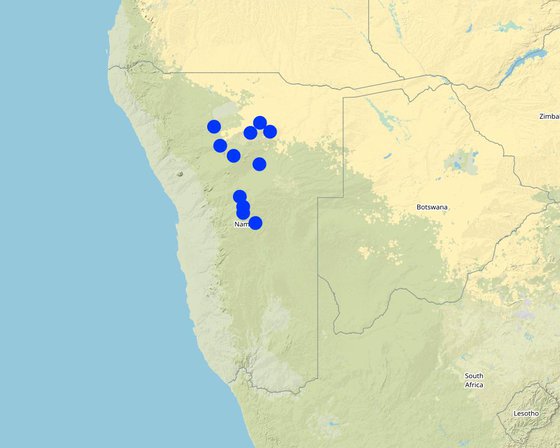
ສະຖານທີ່: Bush control is applied across Namibia on many privately owned farms. Activities are most concentrated in the regions Khomas, Omaheke, Otjozondjupa and Oshikoto., ນາມິເບຍ
ຈໍານວນ ພື້ນທີ່ ທີ່ໃຊ້ ເຕັກໂນໂລຢີ ທີ່ໄດ້ວິເຄາະ: 100-1000 ພຶ້ນທີ່
ການແຜ່ກະຈາຍຂອງເຕັກໂນໂລຢີ: ແຜ່ຂະຫຍາຍຢ່າງໄວວາໃນພື້ນທີ່ (1200.0 km²)
ຢູ່ໃນເຂດປ່າສະຫງວນທີ່ບໍ?:
ວັນທີຂອງການປະຕິບັດ: 2015
ປະເພດຂອງການນໍາສະເໜີ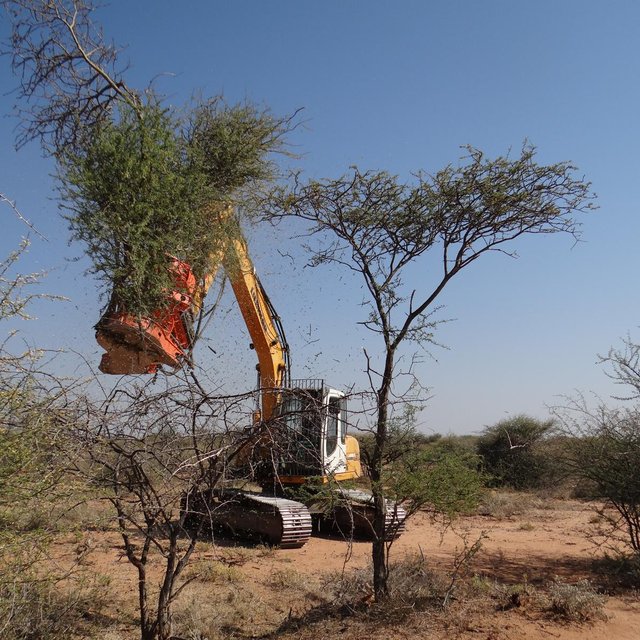
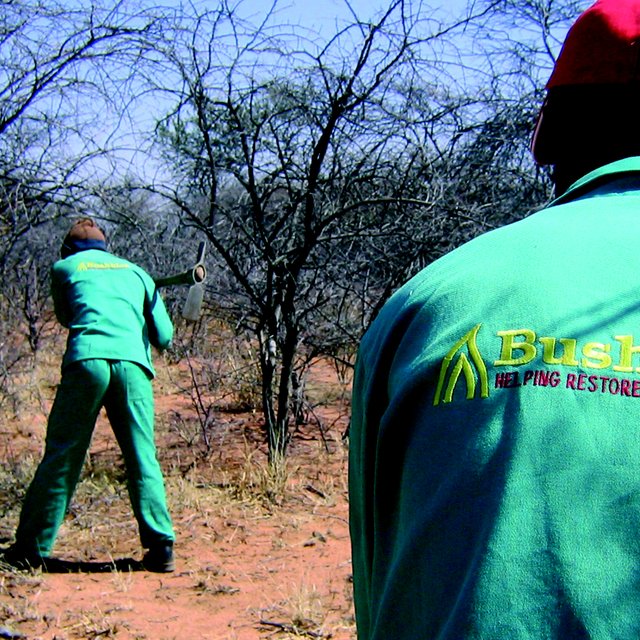




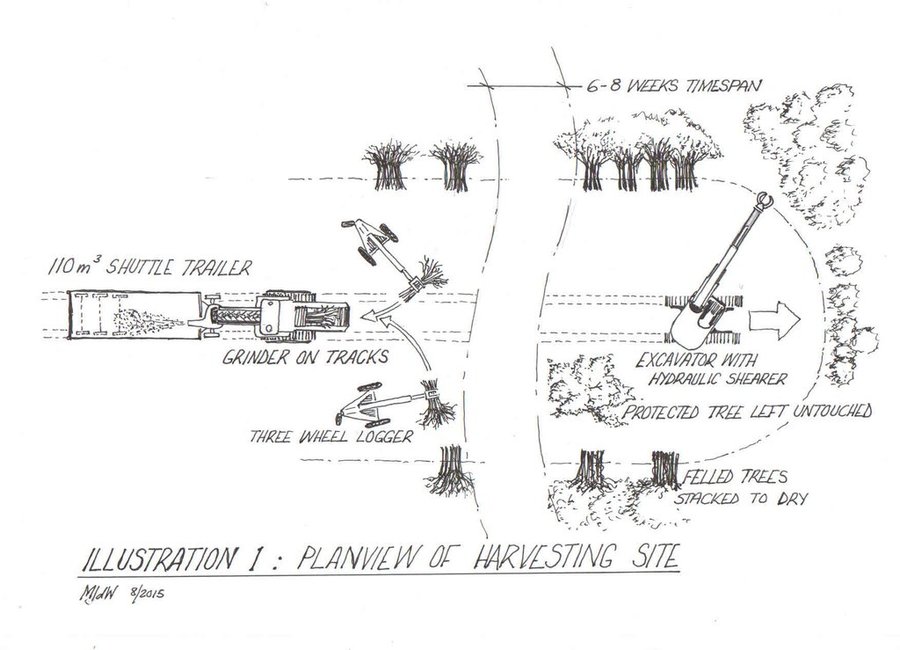
| ລະບຸ ປັດໃຈ ນໍາເຂົ້າ ໃນການຜະລີດ | ຫົວໜ່ວຍ | ປະລິມານ | ຕົ້ນທຶນ ຕໍ່ຫົວໜ່ວຍ (Namibia Dollar (NAD)) | ຕົ້ນທຶນທັງໝົດ ຂອງປັດໃຈຂາເຂົ້າ ໃນການຜະລິດ (Namibia Dollar (NAD)) | % ຂອງຕົ້ນທຶນທັງໝົດ ທີ່ຜູ້ນໍາໃຊ້ທີ່ດິນ ໃຊ້ຈ່າຍເອງ |
| ແຮງງານ | |||||
| 1 x Mechanic | person days | 0.2 | 2000.0 | 400.0 | |
| 4 x Operators | person days | 0.8 | 300.0 | 240.0 | |
| 1 x Operation manager chipping | person days | 0.2 | 1000.0 | 200.0 | |
| 1 x Chipping operator | person days | 2.0 | 150.0 | 300.0 | |
| ອຸປະກອນ | |||||
| 1 x 12t Excavator | pieces | 1.0 | 120.0 | 120.0 | |
| 2 x Hydraulic grab and shearing attachments | pieces | 2.0 | 60.0 | 120.0 | |
| 2 x Three wheel loggers | pieces | 2.0 | 180.0 | 360.0 | |
| 1 x Chipper | pieces | 1.0 | 840.0 | 840.0 | |
| ອື່ນໆ | |||||
| Management and administration overhead | lump sum | 1.0 | 200.0 | 200.0 | |
| 12.0 | |||||
| ຕົ້ນທຶນທັງໝົດ ໃນການຈັດຕັ້ງປະຕິບັດ ເຕັກໂນໂລຢີ | 2'780.0 | ||||
| ຄ່າໃຊ້ຈ່າຍທັງໝົດ ສຳລັບການສ້າງຕັ້ງເຕັກໂນໂລຢີ ເປັນສະກຸນເງີນໂດລາ | 35'641.03 | ||||
Bush-based animal feed production has been successfully trialed and is implemented by various farmers across Namibia.
Carrying capacity of bush controlled land increases if regular aftercare is implemented.
Bush-to-electricity value chain under development. Several industrial off-takers use woody biomass for boilers (heat), the national power utility currently develops a first biomass power plant.
Studies show a direct positive correlation between the extent of bush control and the availability of groundwater.
Bush based value addition, e.g. charcoal production, leads to additional income for land owners and farm workers.
Bush based value addition, e.g. charcoal production, leads to additional income for land owners and farm workers.
Alien species are completely removed where possible (e.g. Prosopis).